1993 CHEVROLET LUMINA service
[x] Cancel search: servicePage 226 of 324

Downloaded from www.Manualslib.com manuals search engine Service & Appearance Care
= = 224
Windshield Wiper Blade
Replacement
Replacement blades come in different
types and are removed in different
ways. Here’s how to remove the type
with a release clip:
1. Pull the windshield wiper ann away
2. Lift the release clip with a
from
the windshield.
screwdriver and pull the blade
assembly
off the wiper arm.
the wiper arm.
3. Push the new wiper blade securely on
Loading Your Vehicle
Two labels on your vehicle show how
much weight it may properly carry. The
Tire-Loading Information label found
on the inside of the trunk lid tells you
the proper size, speed rating and
recommended inflation pressures for
the tires on your vehicle. It also gives
you important information about the
number of people that can be in your
vehicle and the total weight that you
can carry. This weight is called the
Vehicle Capacity Weight and includes
the weight of all occupants, cargo, and
all nonfactory-installed options. The
other label is the Certification label,
on the rear edge
of the driver’s door. It
tells you the
gross weight capacity of
your vehicle, called the GVWR (Gross
Vehicle Weight Rating). The
GVWR
includes the weight of the vehicle, all
occupants, fuel and cargo. Never exceed
the GVWR for your vehicle, or the
Gross Axle Weight Rating
(GAWR) for
either the front or rear axle.
And,
if you do have a heavy load, you
should spread it out. Don’t carry more
than
167 lbs. (75 kg) in your trunk.
Page 228 of 324

Downloaded from www.Manualslib.com manuals search engine 1,
Service & Appearance Care
Inflation-7ire Pressure
The Tire-Loading Information label
which is on the inside of the trunk lid
shows the correct inflation pressures for
your tires, when they’re cold. “Cold” means your vehicle has been sitting for
at least three hours or driven no more
than a mile. Don’t let anyone tell you
that 1
underinflation or overinflation is
all right. It’s not. If your tires don’t
have enough air (un
Bad fuel econon
If your tires have to
(overinflation) you can get:
Unusual wear [*--
Bad handling
Rough ric,
Needless damage from rp-
hazards.
Page 229 of 324

Downloaded from www.Manualslib.com manuals search engine When to Check:
Check your tires once a month or more.
Don't forget your compact spare tire. It
should be at
60 psi (420 kPa).
How to Check
Use a good quality pocket-type gage to
check tire pressure. Simply looking
at
the tires will not tell you the pressure,
especially
if you have radial tires-
which may look properly inflated even
if
they're underinflated.
If your tires have valve caps, be sure to
put them back on. They help prevent
leaks by keeping out dirt and moisture.
Tire Inspection and Rotation
To make your tires last longer, have
them inspected and rotated at the
mileages recommended in the
Maintenance Schedule. See the
Index
under Scheduled Maintenance
Services.
Use this rotation pattern.
Mer the tires have been rotated, adjust
the front and rear inflation pressure as
shown on the Tire-Loading Information
label. Make certain that
all wheel nuts
are properly tightened. See the
Index
under Wheel Nut Torque.
I
Rust or dirt on a wheel, or on
the parts to which it is
fastened, can make the wheel nuts
become loose after
a time. The
wheel could come
off and cause an
accident. When you change a
wheel, remove any rust
or dirt from
places where the wheel attaches to
the vehicle. In an emergency, you
can use a cloth
or a paper towel to
do this; but be sure to use a scraper
or wire brush later,
if you need to,
to get all the rust or dirt off. (See
the
Index under Changing a Flat
Tire.)
L
Page 230 of 324
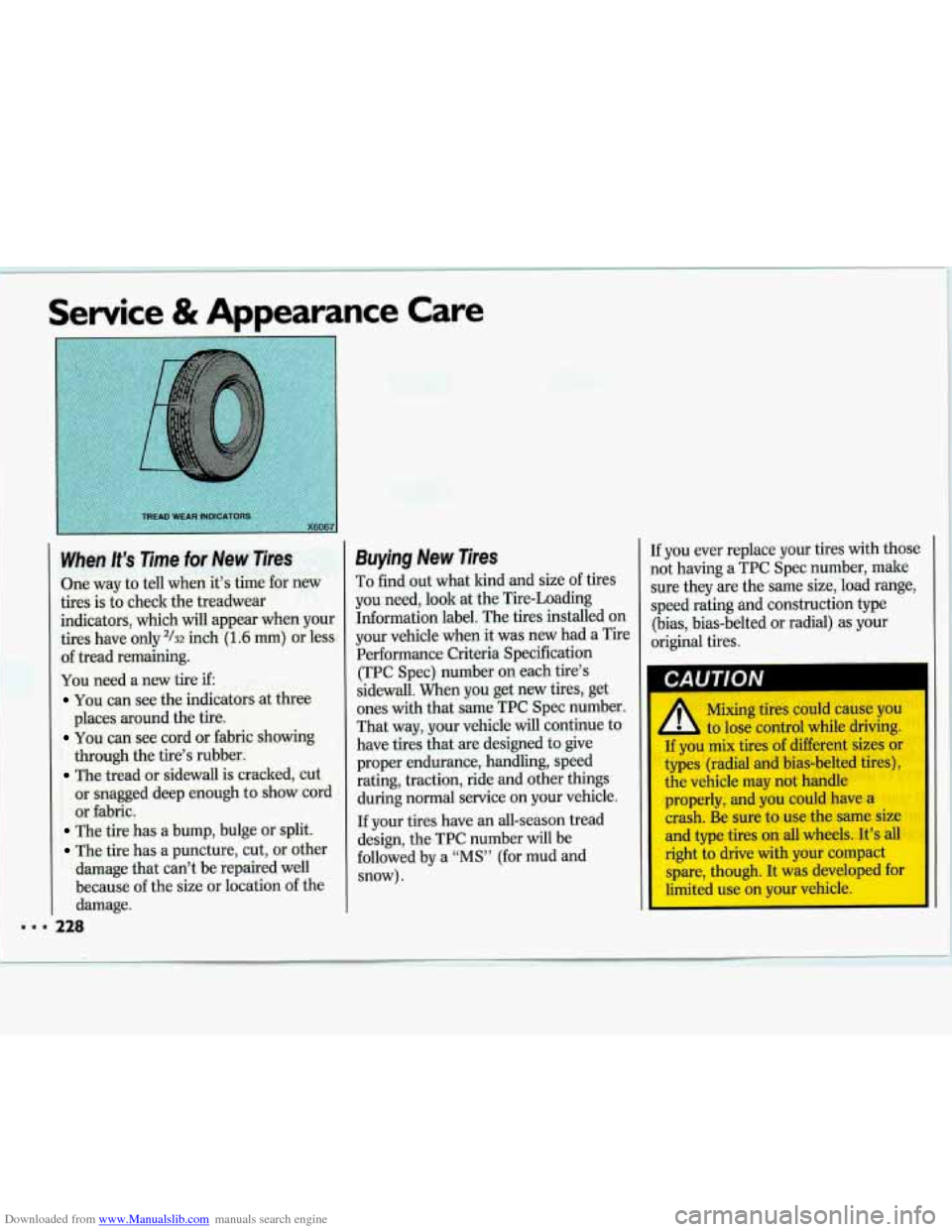
Downloaded from www.Manualslib.com manuals search engine Servi - - & f -- MI -- 3arance Care
When It’s Time for New Tires
One way to tell when it’s time for new
tires is to check the treadwear
indicators, which will appear when your
tires have only
2/32 inch (1.6 mm) or less
of tread remaining.
You need a new tire if:
You can see the indicators at three
You can see cord or fabric showing
The tread or sidewall is cracked, cut
places around
the tire.
through the tire’s rubber.
or snagged deep enough to show cord
or fabric.
The tire has a bump, bulge or split.
The tire has a puncture, cut, or other
damage that can’t be repaired well
because of the size or location of the
damage.
Buying New Tires
To find out what kind and size of tires
you need, look at the Tire-Loading
Information label. The tires installed on
your vehicle when it was new had a Tire
Performance Criteria Specification
(TPC Spec) number on each tire’s
sidewall. When you get new tires, get
ones with that same TPC Spec number.
That way, your vehicle will continue to
have tires that are designed to give
proper endurance, handling, speed
rating, traction, ride and other things
during normal service on your vehicle.
If your tires have an all-season tread
design, the TPC number will be
followed by a
“MS” (for mud and
snow). If
you ever replace your tires with those
not having a TPC Spec number, make sure they are the same size, load range,
speed rating and construction type (bias, bias-belted or radial) as your
original tires.
I CAUTION I
Mixing tires could cause you
to lose control while driving.
If you mix tires of different sizes or
types (radial and bias-belted tires)
,
the vehicle may not handle
properly, and you could have a crash. Be sure to use the same size
and type tires on all wheels. It’s all
right to drive with your compact
spare, though. It was developed for
limited use
on your vehicle.
Page 231 of 324
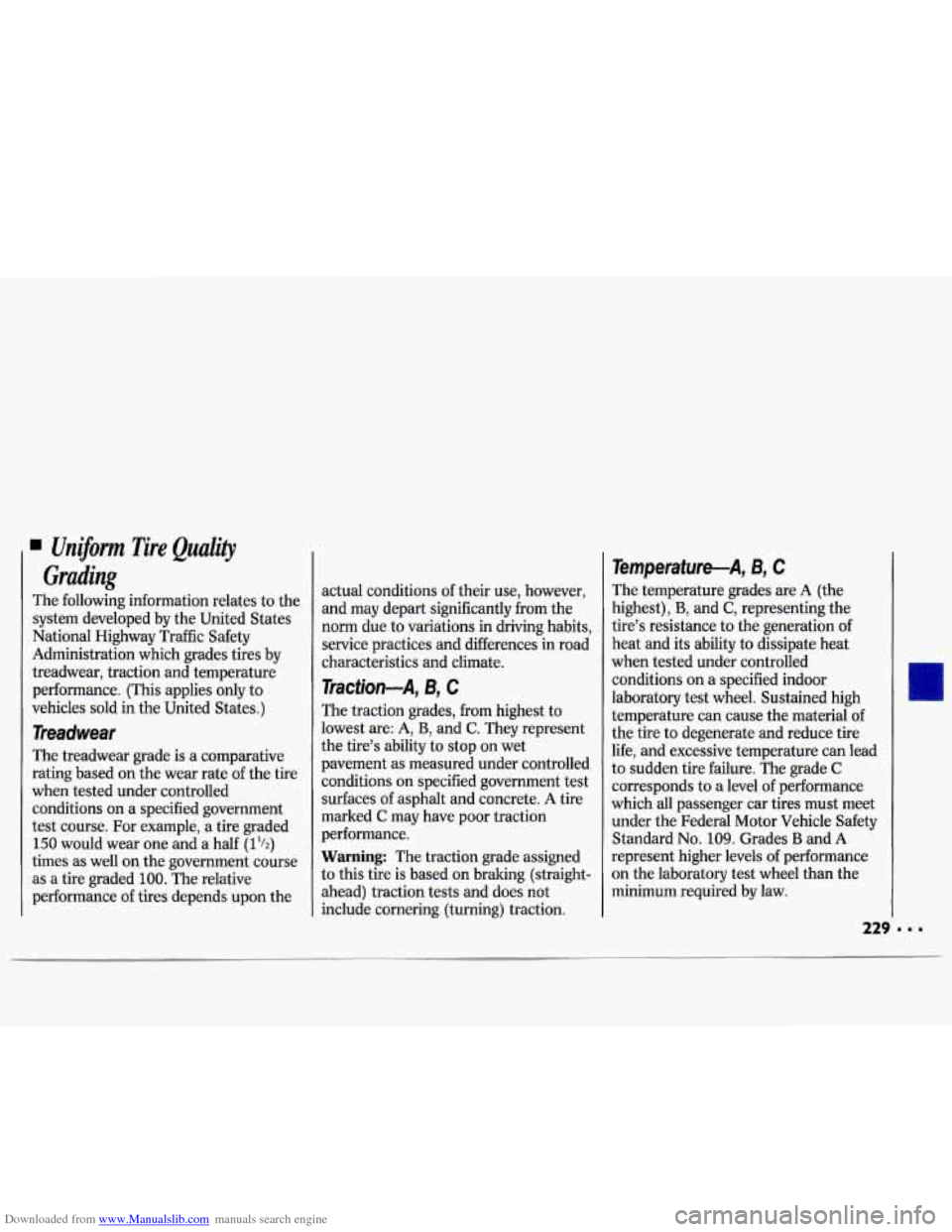
Downloaded from www.Manualslib.com manuals search engine Uniform Tire Quality
Grading
The following information relates to the
system developed by the United States
National Highway Traffic Safety
Administration which grades tires by
treadwear, traction and temperature
performance. (This applies only to
vehicles sold in the United States.)
The treadwear grade is
a comparative
rating based on the wear rate
of the tire
when tested under controlled
conditions on a specified government
test course. For example, a tire graded
150 would wear one and a half (1%)
times as well on the government course
as a tire graded
100. The relative
performance
of tires depends upon the
Treadwear
actual conditions of their use, however,
and may depart significantly
from the
norm due to variations in driving habits,
service practices and differences in road
characteristics and climate.
Traction-A, B, C
The traction grades, from highest to
lowest are: A,
B, and C. They represent
the tire’s ability to stop on wet
pavement as measured under controlled
conditions on specified government test
surfaces of asphalt and concrete. A tire
marked
C may have poor traction
performance.
Warning: The traction grade assigned
to this tire is based on braking (straight-
ahead) traction tests and does not
include cornering (turning) traction.
Temperature-A, B, C
The temperature grades are A (the
highest),
B, and C, representing the
tire’s resistance to the generation of
heat and its ability to dissipate heat
when tested under controlled
conditions on
a specified indoor
laboratory test wheel. Sustained high
temperature can cause the material of
the tire to degenerate and reduce tire
life, and excessive temperature can lead
to sudden tire failure. The grade
C
corresponds to a level of performance
which all passenger car tires must meet under the Federal Motor Vehicle Safety
Standard
No. 109. Grades B and A
represent higher levels of performance
on the laboratory test wheel than the
minimum required by law.
Page 232 of 324
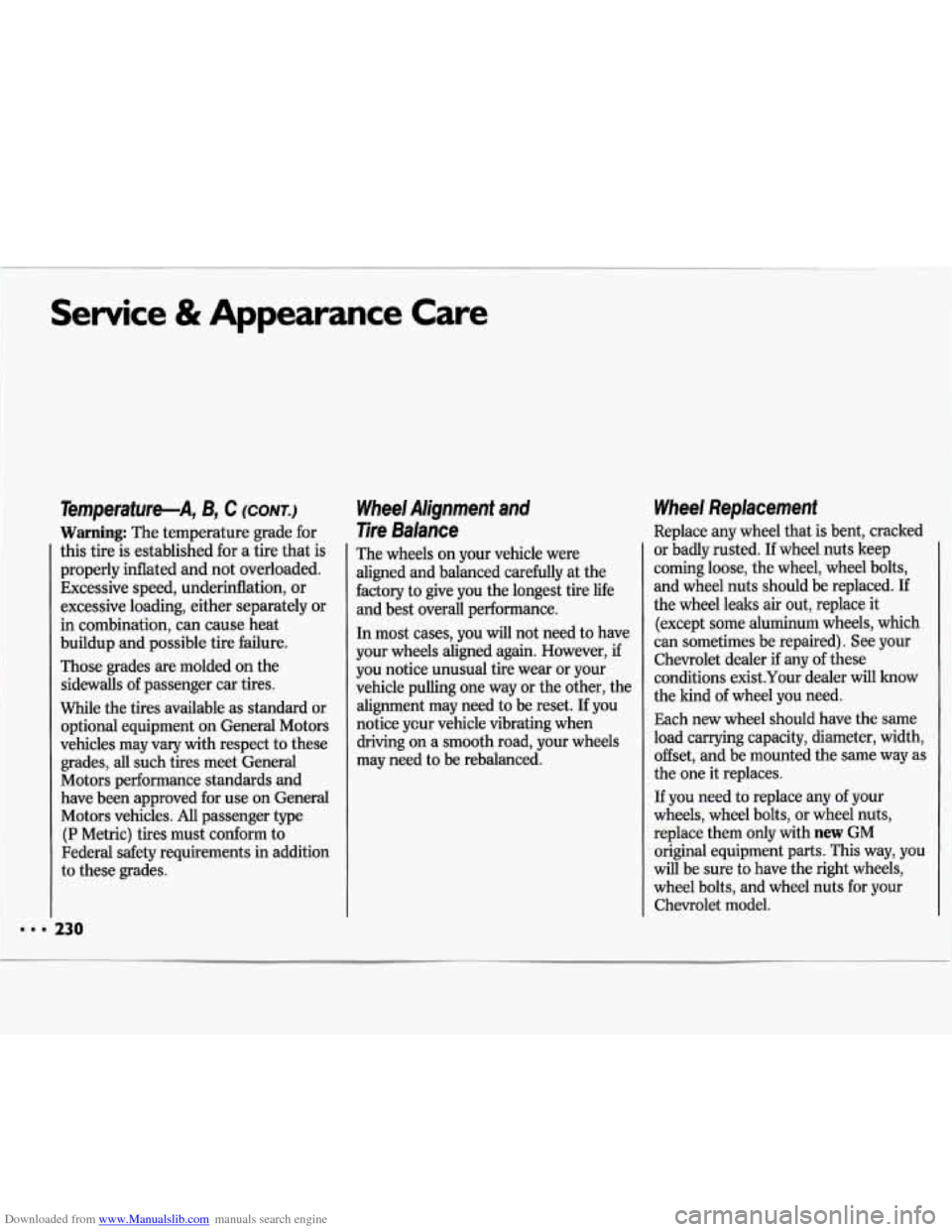
Downloaded from www.Manualslib.com manuals search engine Service & Appearance Care
Temperature-A, B, C (CONT.)
Warning: The temperature grade for
this tire is established for a tire that is
properly inflated and not overloaded.
Excessive speed, underinflation, or
excessive loading, either separately or
in combination, can cause heat
buildup and possible tire failure.
Those grades are molded on the
sidewalls of passenger car tires.
While the tires available as standard or
optional equipment on General Motors
vehicles may vary with respect to these
grades, all such tires meet General
Motors performance standards and
have been approved for use on General
Motors vehicles. All passenger type
(P Metric) tires must conform to
Federal safety requirements in addition
to these grades.
230
Wheel Alignment and
Tire Balance
The wheels on your vehicle were
aligned and balanced carefully at the
factory to give you the longest tire life
and best overall performance.
In most cases, you
will not need to have
your wheels aligned again. However, if
you notice unusual tire wear or your
vehicle pulling one way or the other, the
alignment may need to be reset. If you
notice ycur vehicle vibrating when
driving on a smooth road, your wheels
may need to be rebalanced.
Wheel Replacement
Replace any wheel that is bent, cracked
or badly rusted. If wheel nuts keep
I
coming loose, the wheel, wheel bolts,
and wheel nuts should be replaced. If
the wheel leaks air out, replace
it
(except some aluminum wheels, which
can sometimes be repaired). See your
Chevrolet dealer if any
of these
conditions exist.Your dealer will know
I
the kind of wheel you need.
Each new wheel should have the same
load carrying capacity, diameter, width,
offset, and be mounted the same way
as
the one it replaces.
If you need to replace any
of your
wheels, wheel bolts, or wheel nuts,
replace them only with
new GM
original equipment parts. This way, you
will be sure to have the right wheels,
wheel bolts, and wheel nuts for your
Chevrolet model.
Page 234 of 324
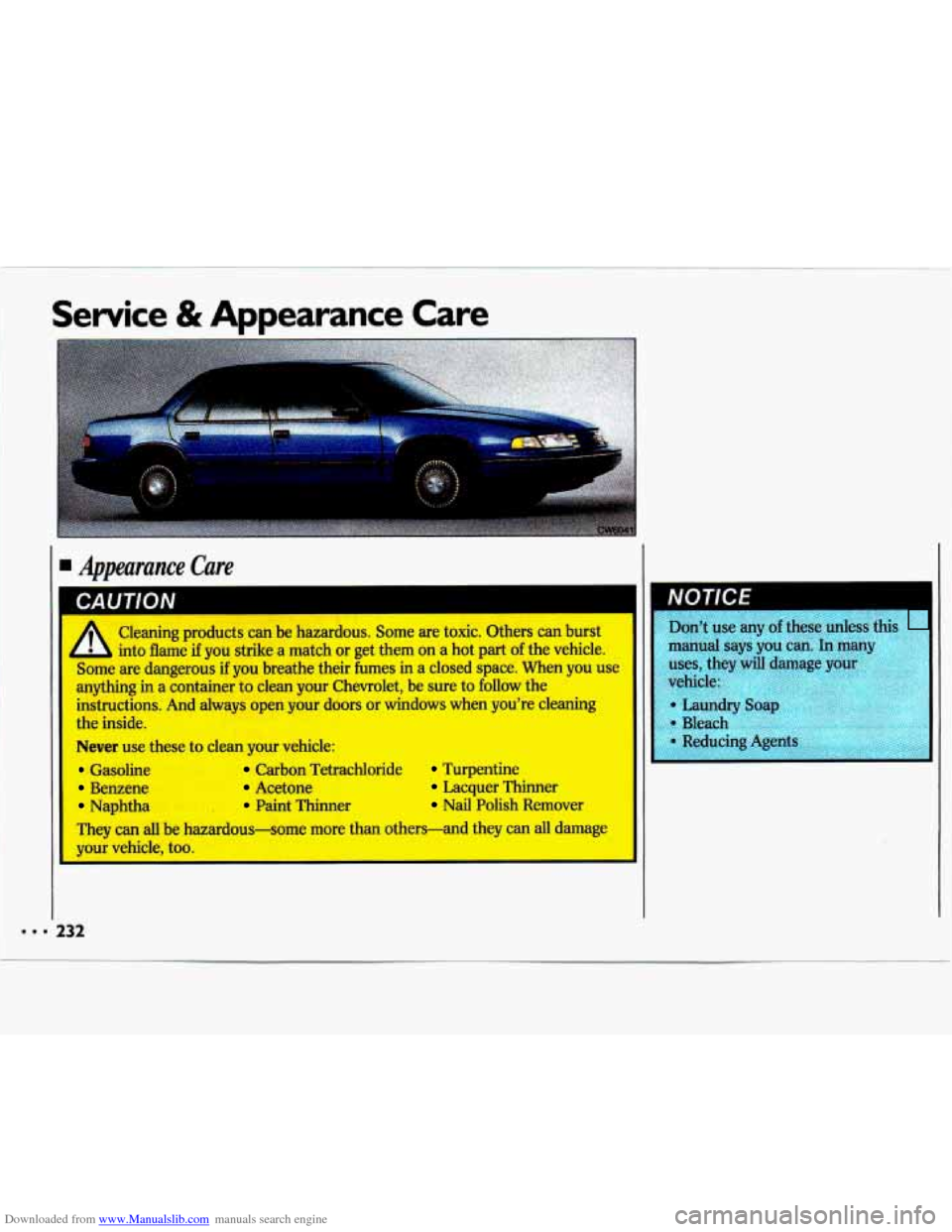
Downloaded from www.Manualslib.com manuals search engine Service & Appearance Care
I Appearance Care
CAUTION
A
Cleaning products can be hazardous. Some are toxic. Others can burst
into flame if you strike a match or get them on a hot part of the vehicle.
Some are dangerous
if you breathe their fumes in a closed space. When you use
anything in a container to clean your Chevrolet, be sure to follow the
I
instructions. And always open your doors or windows when you’\
re cleaning
the inside.
Never use these to clean your vehicle: I
Gasoline Carbon Tetrachloride Turpentine
Benzene Acetone Lacquer Thinner
Naphtha Paint Thinner Nail Polish Remover
They
can all be hazardous-some more than others-and they can all damage
wnllr vphirlp tnn
11 NOTICE
‘Don’t use any of these unless hi^
manual says vou can. In man,
uses, thev v damage vour
vehicl
I
. 232
Page 236 of 324
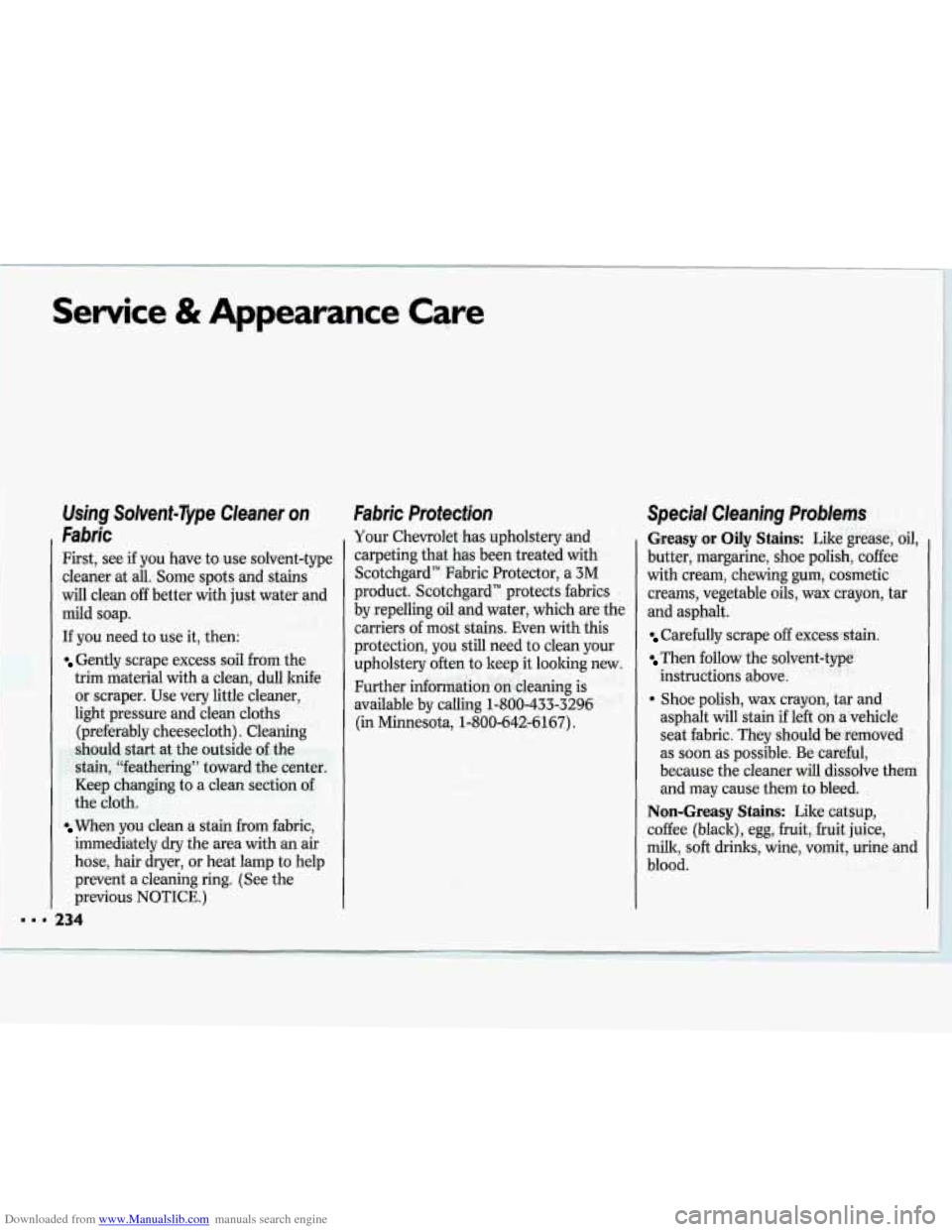
Downloaded from www.Manualslib.com manuals search engine Service & Appearance Care
Using Solvent-Type Cleaner on
Fabric
First, see if you have to use solvent-type
cleaner at all. Some spots and stains
will clean
off better with just water and
mild soap.
If you need to use it, then:
Gently scrape excess soil from the
trim material with a clean, dull knife
or scraper. Use very little cleaner,
light pressure and clean cloths
(preferably cheesecloth). Cleaning
should
start at the outside of the
stain, “feathering” toward the center.
Keep changing to a clean section of
the cloth.
When you clean a stain from fabric,
immediately dry the area with an air
hose, hair dryer, or heat lamp to help
prevent a cleaning ring. (See the
previous NOTICE.)
. 234
Fabric Protection
Your Chevrolet has upholstery and
carpeting that has been treated with
Scotchgard” Fabric Protector, a
3M
product. Scotchgard” protects fabrics
by repelling oil and water, which are the
carriers of most stains. Even with this
protection, you still need to clean your
upholstery often to keep it looking new.
Further information
on cleaning is
available by calling 1-800-433-3296 (in Minnesota, 1-800-642-6167).
Special Cleaning Problems
Greasy or Oily Stains: Like grease, oil,
butter, margarine, shoe polish, coffee
with cream, chewing gum, cosmetic
creams, vegetable oils, wax crayon, tar
and asphalt.
Carefully scrape off excessstain.
Then follow the solvent-typg
. Shoe polish, wax crayon, tar and
instructions
above.
asphalt will stain if left
on a vehicle
seat fabric. They should be removed
as
soon as possible. Be careful,
because the cleaner will dissolve them
and may cause them to bleed.
Non-Greasy Stains: Like catsup,
coffee (black), egg, fruit, fruit juice,
milk, soft drinks, wine, vomit, urine and
blood.